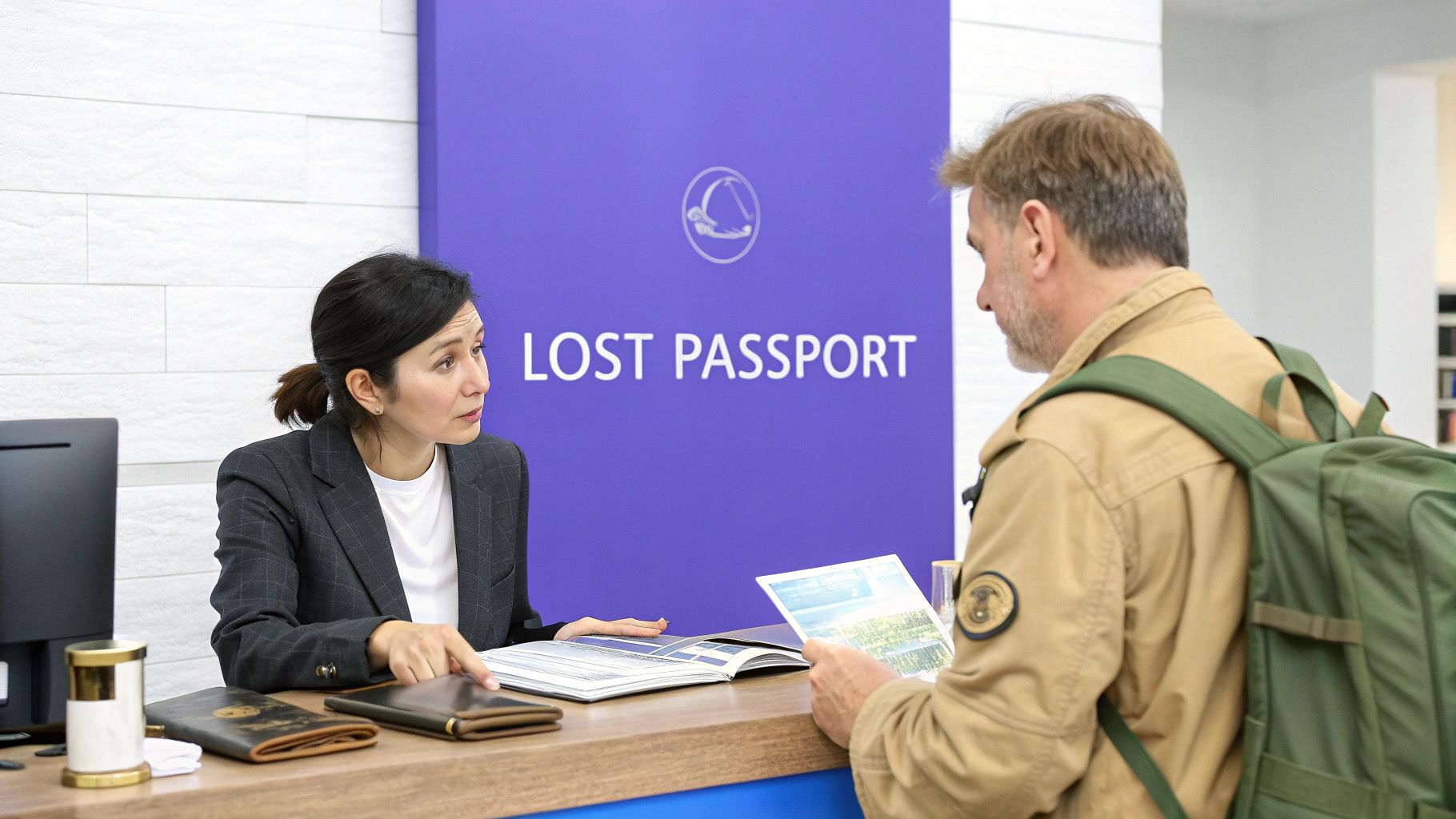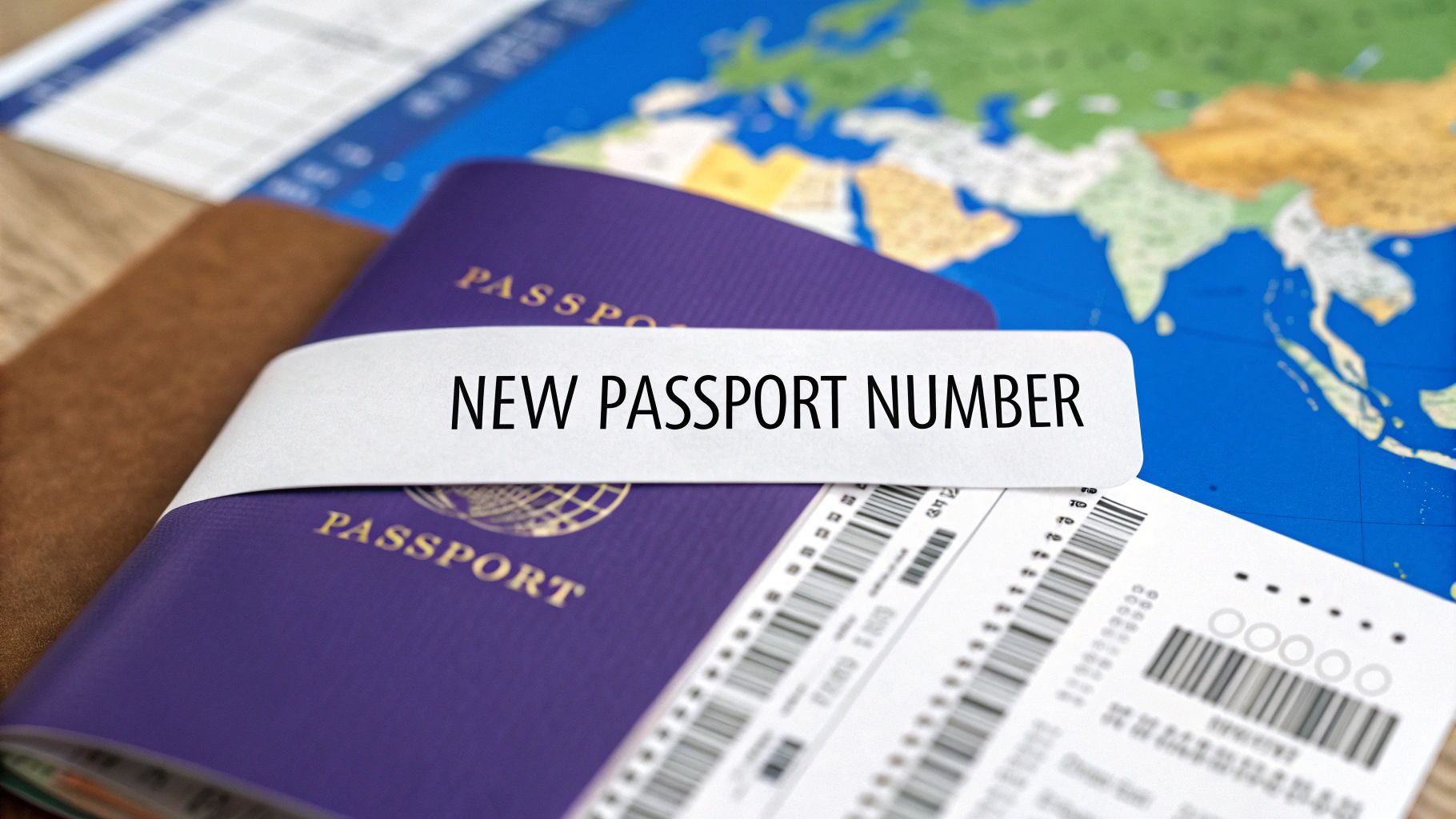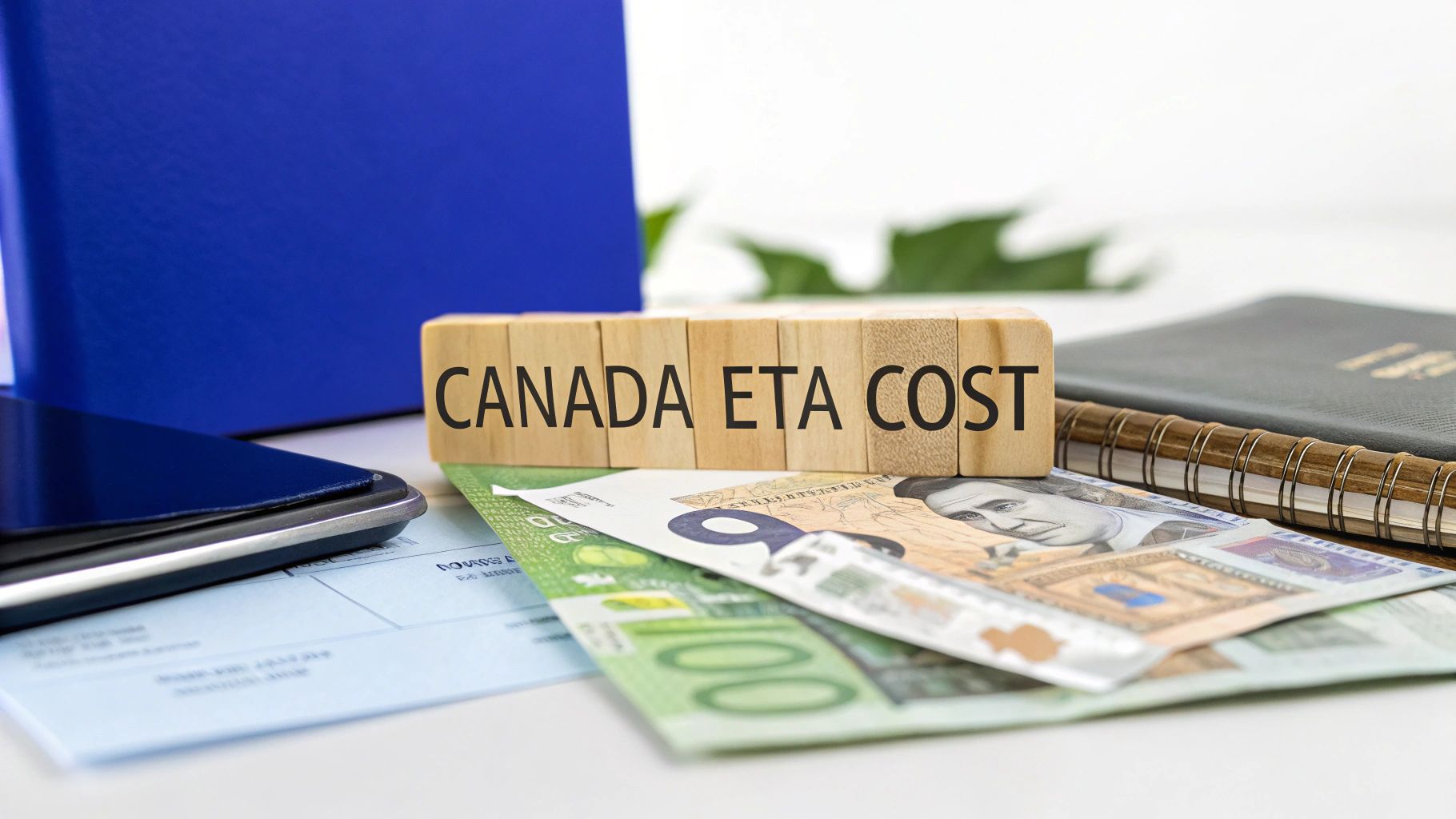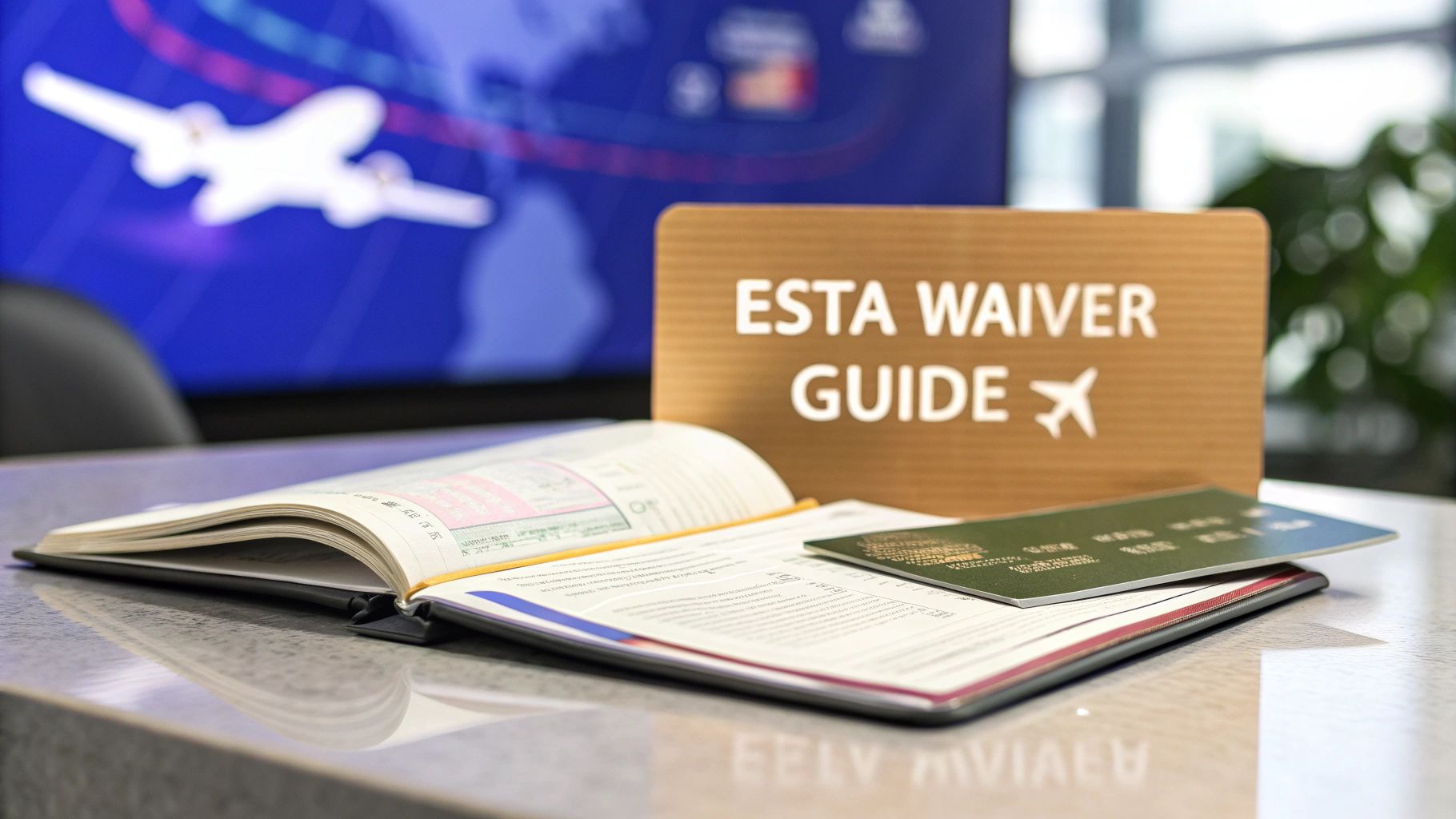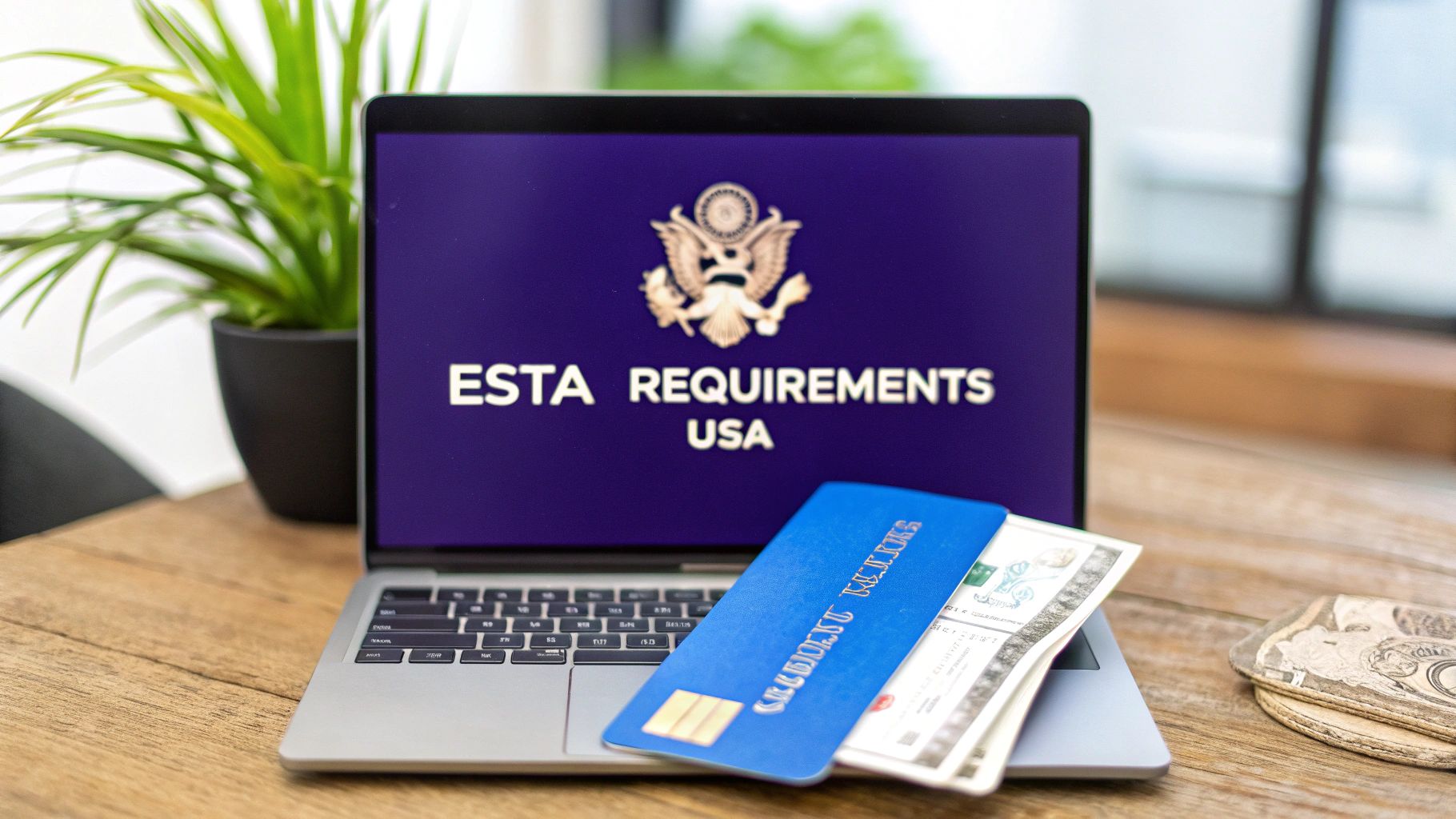
Your Guide to ESTA Requirements USA
Heading to the United States? For many travelers, the first step isn't a visa, but something called an ESTA.
So, what exactly is it? Think of the Electronic System for Travel Authorization (ESTA) as your digital pre-clearance. It's a mandatory online authorization for citizens of Visa Waiver Program (VWP) countries who plan to visit the U.S. for 90 days or less.
It’s not a visa, but you absolutely must have an approved ESTA before you even think about boarding your flight. It’s the green light that says U.S. authorities have pre-screened you and you're eligible to travel.
Your Digital Key to the USA

The ESTA is like a digital handshake with U.S. security. It lets them check out travelers from low-risk countries ahead of time, which makes everything smoother when you land—whether you're there for tourism, a business meeting, or just passing through. It's a core part of the ESTA requirements USA and confirms you're good to go before your trip begins.
Introduced back in 2009, the ESTA has become a critical tool for U.S. border security while making life easier for millions of visitors every year.
ESTA Requirements USA at a Glance
Wondering if you qualify? Here’s a quick rundown of the essential criteria. Meeting all of these is a must for getting your application approved.
To make it simple, we've put the core requirements into a table.
| Requirement Category | Details |
|---|---|
| Citizenship | You must be a citizen of a country in the Visa Waiver Program (VWP). |
| Passport | You need a valid electronic passport (e-Passport) with a biometric chip. |
| Travel Purpose | Your visit must be for tourism, certain types of business, or transit. |
| Duration of Stay | Your planned stay in the U.S. can't be longer than 90 days. |
| Travel Plans | While not always mandatory, having a return or onward ticket is strongly advised. |
Fulfilling these basic requirements is the first and most important step toward a successful ESTA application.
Understanding the ESTA's Purpose
An approved ESTA confirms you're eligible to travel to the U.S. under the VWP, but it's important to know it doesn't guarantee you'll be let in. That final call is always made by a U.S. Customs and Border Protection (CBP) officer when you arrive.
At its heart, the ESTA is a security check. It's designed to stop individuals who might be a security risk from ever getting on a U.S.-bound plane.
While the ESTA makes travel simpler for millions, it's a completely different animal from a traditional visa. If you don't qualify for the VWP, you'll need to go another route. You can learn more in our guide on the different types of U.S. visas. For more general travel planning advice for trips to the USA, the Explore Effortlessly website is another great resource.
First Things First: Are You Eligible for the Visa Waiver Program?
Before you even think about starting an ESTA application, you need to make sure you're eligible for the Visa Waiver Program (VWP). Think of the VWP as an exclusive club. If you’re not a member, you can't get an ESTA—it’s as simple as that.
This program lets citizens from 42 specific countries travel to the United States for up to 90 days for tourism or business, all without needing a traditional visa.
The first and most important hurdle is your citizenship. If your country isn't on the VWP list, you'll have to go the traditional route and apply for a standard U.S. visa. Checking this list is the very first step in meeting the ESTA requirements USA.
Passport Rules and Why You're Traveling
Okay, so you're from a VWP country. Great! But that's not the only piece of the puzzle. Your passport has to meet modern security standards.
Every VWP traveler must have a valid e-Passport. This isn't your old-school paper booklet; it contains a small electronic chip that stores your biometric information, adding a critical layer of security. You can spot an e-Passport by the small, rectangular camera-like symbol on its front cover.
Your reason for visiting is just as crucial as your documents. The VWP is pretty strict about what you can—and can't—do during your stay.
So, what are you allowed to do?
- Tourism: Vacations, visiting your cousin in California, or attending a friend's wedding all fall under this.
- Business: You can fly in for business meetings, consult with associates, negotiate a contract, or attend a professional conference.
- Transit: Just passing through the U.S. on your way somewhere else? You'll still need an ESTA for that.
It's vital to know the limits. Trying to use an ESTA to enroll in a university course for credit, take a job, or work as a foreign journalist is a huge no-no and can land you in serious trouble with U.S. immigration.
Think of an ESTA as a key for short-term visits, not a backdoor to working or studying in the U.S. Make sure your travel plans fit squarely within the VWP's approved activities to avoid any headaches at the border.
This kind of digital travel authorization is becoming the new normal around the world. As you plan other trips, you might want to read up on Europe's ETIAS travel requirement, which is a similar system that will soon be required for many travelers.
What Could Get You Disqualified?
Even if you're from an eligible country with the right passport, certain things in your past can make you ineligible for the VWP. For example, if you've ever overstayed a previous U.S. visa or have a criminal record, your ESTA application is almost certain to be denied.
Your travel history is also under the microscope. If you have traveled to or been present in countries like Iran, Iraq, North Korea, Sudan, or Syria on or after March 1, 2011, you may not qualify for an ESTA. In that case, you'll need to apply for a visa instead.
Always be honest and review these conditions carefully before you apply. It'll save you the time and frustration of an unnecessary denial.
Getting Your Documents and Information Ready
Before you even think about starting the ESTA application, let's get organized. Think of it like packing for a trip—having everything you need laid out beforehand makes the whole process faster, smoother, and way less stressful.
A single typo or a mixed-up date can trigger an automatic denial, so accuracy is everything. By gathering your documents first, you can fill out the application in one go and avoid the kind of mistakes that happen when you're scrambling to find a piece of information. This isn't just about saving time; it's about getting it right from the start.
Your ESTA Application Checklist
The ESTA form asks for a few key pieces of information. Treat this as your personal checklist. Once you have all of this in front of you, you're good to go.
It all boils down to three main categories.
1. Your Passport Details
This is the most important document of all. You'll need either a clear digital copy or the physical passport right in front of you. If you need a hand with this step, our guide on how to properly scan your passport will walk you through it.
Make sure you have:
- Passport Number: Enter this exactly as it appears on your passport.
- Country of Citizenship: The country that issued your passport.
- Passport Issuance Date: The day your passport was officially issued.
- Passport Expiration Date: The day your passport expires. Remember, your passport must be valid for your entire planned stay in the U.S.
2. Personal and Contact Info
This section is how U.S. authorities confirm who you are and how to reach you if necessary.
You'll need:
- Full Name: Make sure it matches your passport perfectly.
- Date and City of Birth: As listed on your official documents.
- Parents' Names: You'll need to provide the first and last names for both of your parents.
- Home Address and Phone Number: Your current contact information.
- Email Address: This is critical. Your official ESTA notification will be sent here, so double-check it for typos.
3. Employment and Emergency Contact
These details help establish your ties to your home country and give authorities a point of contact just in case.
Be ready with:
- Current or Previous Employer's Name and Address: This shows you have a job and life to return to.
- Emergency Contact: The name, phone number, and email of someone who can be reached in an emergency. This person can be inside or outside the U.S.
Having these details organized before you click "apply" is like having your ingredients measured out before you start baking. It guarantees a smooth process and seriously cuts down the risk of a simple mistake derailing your travel plans.
A tiny error, like swapping two numbers in your passport, can be the difference between approval and denial. Taking a few extra minutes to get your information straight is the best thing you can do for your trip.
How to Complete the ESTA Application
Navigating official government forms can feel a bit intimidating, but the online ESTA application is surprisingly straightforward. Think of it as a simple, step-by-step conversation to confirm you’re eligible for visa-free travel.
Let's walk through the process together, from start to finish. Following these steps carefully helps make sure you meet all the esta requirements usa.
First things first, you need to find the official application portal. Be careful here—a lot of third-party sites look like the real deal but aren't. Once you're on the correct government page, you’ll start by entering your personal details exactly as they appear on your passport. That means your full name, birthdate, and passport number.
Next, you'll upload a digital copy of your passport. The system is pretty smart and will try to auto-fill some of the fields for you, but you absolutely have to double-check everything. A tiny typo can be the difference between approval and denial, so precision is your best friend.
Entering Your Travel and Contact Details
After your passport info is squared away, the application will ask for a bit more about you and your trip. This includes your contact information—your home address, phone number, and a good email address. That email is crucial because it’s where your official ESTA status notification will land.
You'll also need to have this information handy:
- Parents' Names: You'll be asked for both of your parents' first and last names.
- Employment Information: Providing details about your current or most recent job helps establish your ties to your home country. It’s a standard part of the process.
- Emergency Contact: You’ll need the name, email, and phone number for someone who can be contacted in an emergency. This person can be inside or outside the U.S.
This checklist gives you a visual reminder of the key information needed for your ESTA application.

Having your passport, contact info, and emergency details ready to go will make the whole thing much faster.
Answering the Eligibility Questions
The final stretch of the application is a series of security-related questions. These are simple "yes" or "no" questions about your health, any criminal history, and your past travel. It is absolutely essential that you answer every single one of them honestly.
Answering "yes" to certain questions might lead to an automatic denial, which just means you'll need to apply for a traditional visa instead. If you want to know more about what happens next, our guide to the ESTA approval service breaks down the different outcomes.
The eligibility questions are a critical security check. Honesty is non-negotiable, as providing false information can lead to a permanent ban from entering the United States.
Once you’ve answered all the questions and given your application one final review for accuracy, you’re ready for the payment step. The U.S. government charges a small fee to process the application. After you pay, your application is officially submitted.
You'll usually get a response within 72 hours. Make sure to save the application number they give you—you'll need it to check your status online. The most common outcomes are "Authorization Approved," "Travel Not Authorized," or "Pending."
Avoiding Common ESTA Application Mistakes
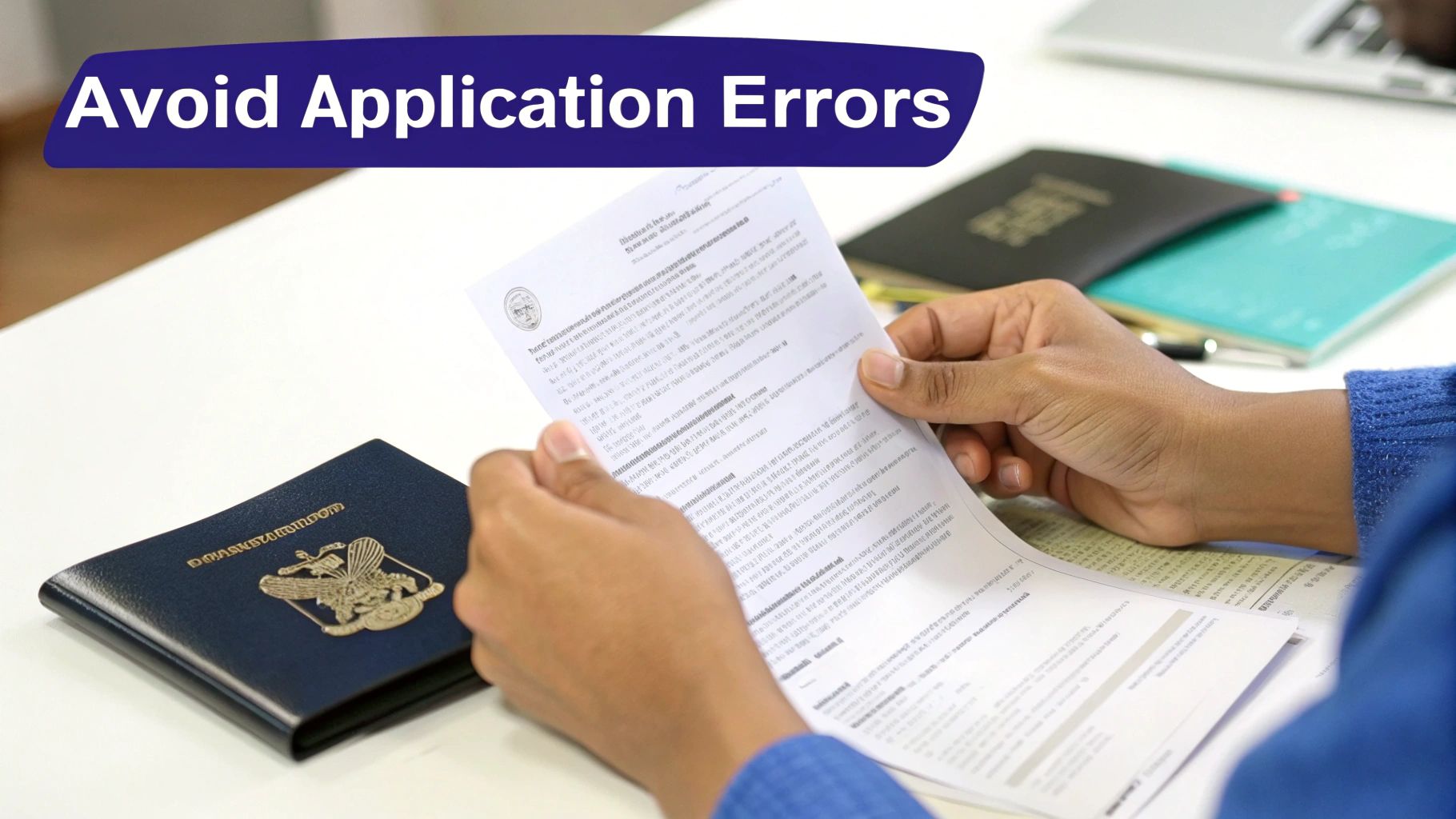
An ESTA denial is one of the fastest ways to derail your travel plans. It’s a frustrating roadblock, and surprisingly, the culprit is often a simple mistake—a single typo or a misunderstood question.
Navigating the esta requirements usa isn't just about knowing what information to provide. It's about understanding how easy it is to make a small error with big consequences. These common pitfalls are surprisingly easy to fall into but just as easy to avoid with a little care and attention.
Imagine you’ve booked non-refundable flights to New York, only to have your ESTA denied because you rushed and entered your birth year incorrectly. This one tiny slip-up could force you into the long, expensive, and stressful process of applying for a B1/B2 visitor visa at a U.S. embassy—a process that can take weeks or even months.
Data Entry and Passport Errors
By far, the most frequent source of denials is simple human error. The ESTA system is automated and unforgiving; it can’t guess that you meant to type a "5" instead of a "6."
- Incorrect Passport Number: Swapping a couple of digits or misreading a character is a classic mistake. Always double-check this number against your physical passport before you hit submit.
- Name Mismatches: Your name must be entered exactly as it appears in the Machine-Readable Zone (MRZ) at the bottom of your passport’s photo page. This includes any hyphens, special characters, or multiple last names.
- Expired Passport: Your passport must be valid for your entire intended stay. Applying with a passport that's about to expire is a guaranteed rejection.
These details are the foundation of your application. Getting them wrong is like building a house on a shaky foundation—it just won't stand. For a deeper dive, our guide offers detailed ESTA application help to make sure you get it right the first time.
Misinterpreting Eligibility Questions
The security questions toward the end of the application are absolutely critical. They are direct, "yes" or "no" questions about your background, including any criminal history and previous travel to certain countries. It is crucial that you read each one carefully and answer honestly.
Misunderstanding or misrepresenting your history on these eligibility questions is one of the fastest ways to get your application denied. Answering "yes" to certain questions may mean you need to apply for a visa instead, but a dishonest "no" could result in a long-term ban from entering the U.S.
To help you visualize these common tripwires, we’ve put together a quick reference table.
Common ESTA Application Errors and How to Avoid Them
The table below breaks down the most common mistakes travelers make and what you should do instead. A moment of prevention here is worth weeks of headaches later.
| Common Mistake | Correct Action | Potential Consequence |
|---|---|---|
| Typing a Nickname | Use your full legal name as shown on your passport’s Machine-Readable Zone (MRZ). | Instant denial due to name mismatch with official records. |
| Entering Wrong Passport Number | Double-check every digit. A common error is mixing up the letter 'O' and the number '0'. | Application will be rejected as it won’t match your passport data. |
| Guessing at Security Questions | Read each question carefully. If unsure, research the question's meaning before answering. | A wrong answer can lead to denial and may be flagged as misrepresentation. |
| Using an Expiring Passport | Ensure your passport is valid for your entire planned trip. Renew it before applying if necessary. | Your ESTA will be denied or will expire along with your passport. |
| Not Answering All Questions | Fill out every required field. The system will not process incomplete applications. | The application will be immediately rejected for being incomplete. |
Taking a few extra minutes to review your application before submitting it is the single best thing you can do to ensure a smooth approval.
If your ESTA application is denied for any reason, your only path forward is to apply for a nonimmigrant visa at the nearest U.S. Embassy or Consulate. This is a much more involved process, which really underscores why getting your ESTA right from the start is so important.
What to Do After Your ESTA Is Approved
So, you’ve got the "Authorization Approved" email. Great news! That’s the biggest hurdle out of the way for your trip to the States. But hold on—getting approved isn't quite the finish line.
An approved ESTA is typically valid for two years from the day it's issued, or until your passport expires, whichever comes first. This means you can take multiple trips to the U.S. during that time without reapplying, as long as each stay is 90 days or less.
It's super important to remember this: an approved ESTA doesn't guarantee you'll be let into the country. Think of it as your pass to get on the plane. The final say always comes from the U.S. Customs and Border Protection (CBP) officer who greets you on arrival.
Managing Your Approved ESTA
First thing's first: find your application number in the approval email and save it somewhere safe. You don’t technically need to print anything out for your trip, but having a digital or paper copy of your approval is a smart backup, just in case.
You also need to know when it's time to get a new ESTA. Your current one is instantly void if you get a new passport, change your name, or change your gender. The same goes if your answers to any of the "yes/no" eligibility questions have changed since you first applied.
An approved ESTA is digitally tied to the specific passport you used to apply. If that passport is lost, stolen, or expires, your ESTA is no longer valid—even if you still have time left on the two-year clock.
Keeping these details in mind is the key to making sure your travel authorization is ready to go whenever you are. For a deeper dive into keeping your travel pass up-to-date, check out our guide on how to renew your U.S. ESTA. Staying on top of the esta requirements usa even after you're approved will help every trip go off without a hitch.
Your Top ESTA Questions, Answered
Got questions about the ESTA process or the official esta requirements usa? You're not alone. Here are some quick, clear answers to the things travelers ask us most.
How Far in Advance Should I Apply for an ESTA?
Our advice? Apply at least 72 hours before you fly. Don't leave it to the last minute.
While most ESTA applications get approved in just a few minutes, some get flagged for a manual review, which can take longer. Applying a few days early gives you a crucial buffer. If your ESTA is unexpectedly denied, you'll still have time to go the traditional route and apply for a B-1/B-2 visitor visa.
What Happens if My Passport Expires Before My ESTA?
This is a big one. Your ESTA is electronically tied directly to your passport. The moment that passport expires, your ESTA becomes invalid, too—even if you still have time left on its two-year validity.
Think of them as a matched set. If you get a new passport for any reason, you absolutely must apply for a new ESTA with the updated passport information before you can travel to the US again.
Can I Use an ESTA to Work or Study in the US?
Definitely not. An ESTA is designed for very specific purposes: tourism, certain business activities (like attending a conference or negotiating a contract), or transiting through the US.
It absolutely does not give you permission to take a job or enroll in a study course for academic credit. For those activities, you'll need the right kind of visa, like an F-1 for students or an H-1B for skilled workers. Using an ESTA for work or study is a serious violation of US immigration rules.
